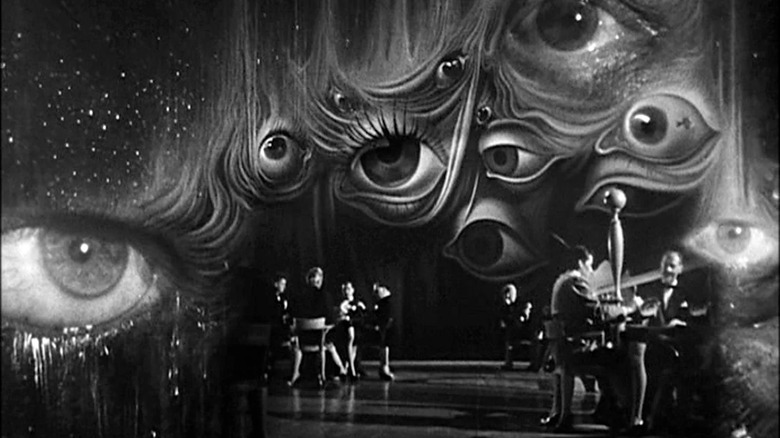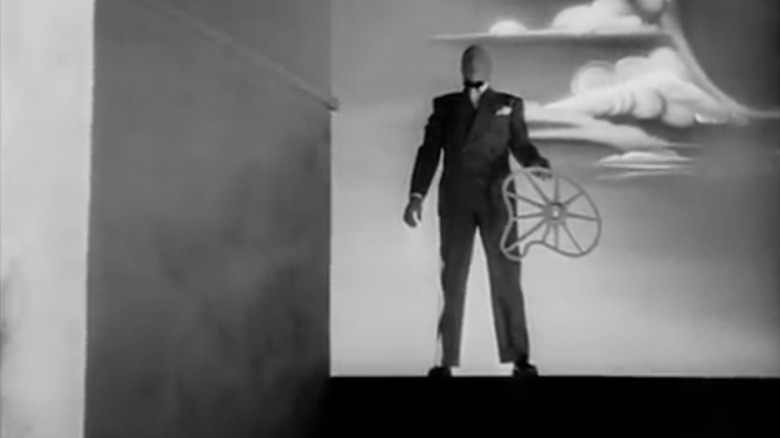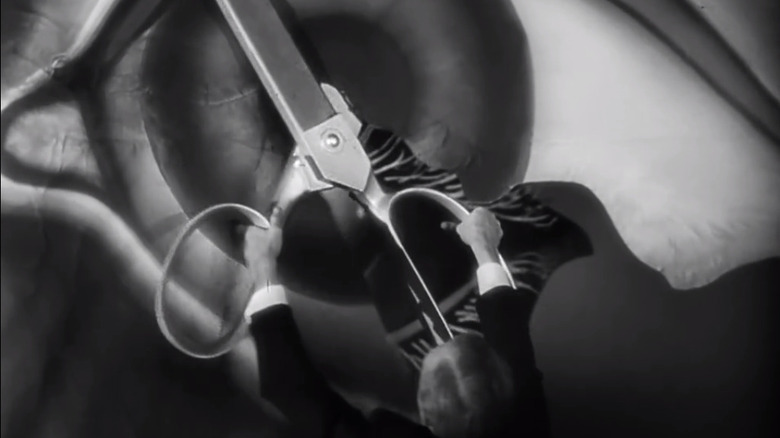Alfred Hitchcock And Salvador Dalí's Original Spellbound Plan Involved Ingrid Bergman And A Lot Of Ants
Alfred Hitchcock's 1945 film "Spellbound" is an earnest and intense attempt to suss out the complexities of trauma. In the film, Ingrid Bergman plays a no-nonsense psychoanalyst at a clinic in Vermont, devoted to the then-becoming-popular forms of psychoanalysis. Gregory Peck plays a mild-mannered doctor who starts working at the same clinic, and the two fall in love. Peck, however, fears he hasn't always been so mild-mannered as he is now and eventually confesses to Ingrid Bergman that he killed another man and took his place. Thanks to a bout of amnesia, however, he can't recall which of the two men he actually is. Bergman is surprisingly understanding, and aims to help him solve the mystery.
The centerpiece of "Spellbound" is its famous Salvador Dalí-designed sequence wherein Peck recalls the bizarre details of a dream he had. The sequence involves images of an old man, melted wagon wheels, faceless figures, floating eyeballs, ballet, and stark, sharp angles. In the film, a psychiatrist is on hand to interpret the symbols, but in experience, the sequence defies basic explanation. After all, early surrealists founded the movement on notions of artistic purity; release what is inside the mind without the pesky filter of conscious thought. Much of surrealism is predicated on the complete lack of easy interpretation.
Hitchcock, in speaking with François Truffaut in the celebrated interview book "Hitchcock/Truffaut," explained some of his thinking behind the dream sequence, and how Dalí had some fun ideas that were simply not practical. Dalí, for instance, wanted to coat Bergman in ants, a common animal seen throughout Dalí's work. Hitchcock also had grander ideas for the way he wanted the dream sequence filmed which were, he recalls, far too expensive to construct.
The sharpness
The famed Spanish artist Salvador Dalí had worked in film on numerous occasions prior to "Spellbound," having made his co-directorial debut in 1929 with the film school staple "Un Chien Andalou," which he made with Luis Buñuel. He and Buñuel also collaborated on "L'Age D'Or," a more pointedly political film that depicts politicians and clergymen as buffoons and lotharios. In the mid-1940s, Dalí – hot commodity among Hollywood's upper tiers — collaborated with any number of movie stars, including Harpo Marx and Walt Disney. The Disney film, incidentally, would be completed in 2003. "Destino" was nominated for an Academy Award.
"Spellbound" was probably Dalí's highest-profile film work, and Hitchcock had requested the artist specifically. Not because of Dalí's surrealist imagery necessarily, but for his clarity. Looking at a Dalí paining, one might notice the starkness of his landscapes. Amidst the elongated elephants and semiliquid clocks are sharp, straight lines and high-contrast colors. It was that clarity — that sense of being hyperreal — that Hitchcock appreciated. As he told Truffaut:
"I asked [executive David O.] Selznick if he could get Dalí to work with us and he agreed, though I think he didn't really understand my reasons for wanting Dalí. He probably thought I wanted his collaboration for publicity purposes. The real reason was that I wanted to convey the dreams with great visual sharpness and clarity, sharper than the film itself. I wanted Dalí because of the architectural sharpness of his work. Chirico has the same quality, you know, the long shadows, the infinity of distance, and the converging lines of perspective."
Giorgio de Chirico (1888 – 1978) was an Italian painter sometimes called the grandfather of surrealism.
Dalí had some strange ideas
In what might be an obvious observation, Hitchcock found that Dalí's ideas for "Spellbound" were a little odd. As mentioned, ants are a common motif in Dalí's work, and Dalí wanted ants in "Spellbound." Many, many ants. Dalí envisioned a life-size statue covered in ants that would be replaced by the film's star. As far as I have been able to determine, Bergman was not asked to coat herself in ants for "Spellbound," so that part of the sequence seemingly never made its way beyond the idea phase. Additionally, Hitchcock seems to have had some bizarre notions of his own, wanting to use natural lighting for the sequence. Ultimately, both ideas were shot down. As Hitchcock describes:
"But Dalí had some strange ideas; he wanted a statue to crack like a shell falling apart, with ants crawling all over it, and underneath, there would be Ingrid Bergman, covered by the ants! It just wasn't possible. My idea was to shoot the Dalí dream scenes in the open air so that the whole thing, photographed in real sunshine, would be terribly sharp. I was very keen on that idea, but the producers were concerned about the expense. So we shot the dream in the studios."
The sequence is gorgeous, and stands apart not just from "Spellbound," but from a great deal of Hitchcock's work, which rarely skewed that arty. But one can see in other movies what Hitchcock might have been driving at in his desire for natural light. Look at the dream sequence in Ingmar Bergman's "Wild Strawberries" to see what Hitchcock was likely going for.
"Spellbound" lost Best Picture to Billy Wilder's "The Lost Weekend" that year, another film with a hallucinatory dream sequence. Fascinating.


